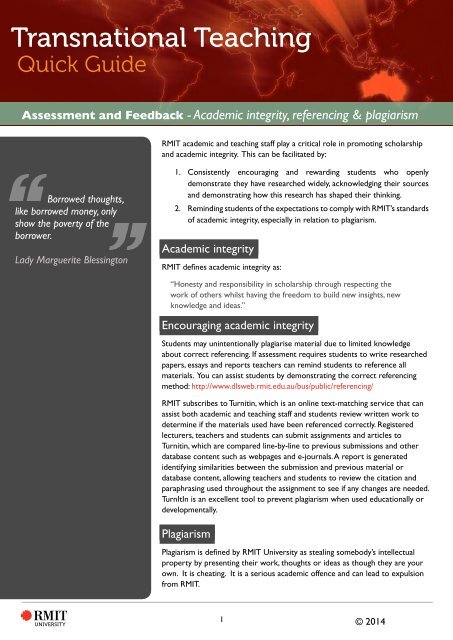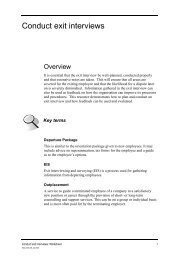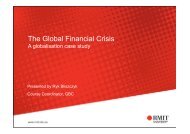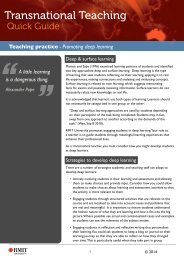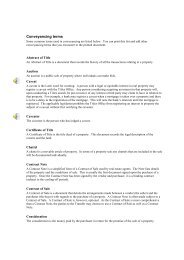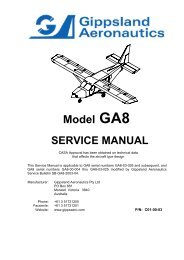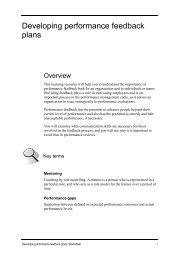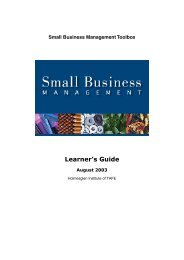Academic integrity & plagiarism - RMIT University
Academic integrity & plagiarism - RMIT University
Academic integrity & plagiarism - RMIT University
Create successful ePaper yourself
Turn your PDF publications into a flip-book with our unique Google optimized e-Paper software.
Transnational Teaching<br />
Quick Guide<br />
Assessment and Feedback - <strong>Academic</strong> <strong>integrity</strong>, referencing & <strong>plagiarism</strong><br />
<strong>RMIT</strong> academic and teaching staff play a critical role in promoting scholarship<br />
and academic <strong>integrity</strong>. This can be facilitated by:<br />
Borrowed thoughts,<br />
like borrowed money, only<br />
show the poverty of the<br />
borrower.<br />
Lady Marguerite Blessington<br />
1. Consistently encouraging and rewarding students who openly<br />
demonstrate they have researched widely, acknowledging their sources<br />
and demonstrating how this research has shaped their thinking.<br />
2. Reminding students of the expectations to comply with <strong>RMIT</strong>’s standards<br />
of academic <strong>integrity</strong>, especially in relation to <strong>plagiarism</strong>.<br />
<strong>Academic</strong> <strong>integrity</strong><br />
<strong>RMIT</strong> defines academic <strong>integrity</strong> as:<br />
“Honesty and responsibility in scholarship through respecting the<br />
work of others whilst having the freedom to build new insights, new<br />
knowledge and ideas.”<br />
Encouraging academic <strong>integrity</strong><br />
Students may unintentionally plagiarise material due to limited knowledge<br />
about correct referencing. If assessment requires students to write researched<br />
papers, essays and reports teachers can remind students to reference all<br />
materials. You can assist students by demonstrating the correct referencing<br />
method: http://www.dlsweb.rmit.edu.au/bus/public/referencing/<br />
<strong>RMIT</strong> subscribes to Turnitin, which is an online text-matching service that can<br />
assist both academic and teaching staff and students review written work to<br />
determine if the materials used have been referenced correctly. Registered<br />
lecturers, teachers and students can submit assignments and articles to<br />
Turnitin, which are compared line-by-line to previous submissions and other<br />
database content such as webpages and e-journals. A report is generated<br />
identifying similarities between the submission and previous material or<br />
database content, allowing teachers and students to review the citation and<br />
paraphrasing used throughout the assignment to see if any changes are needed.<br />
TurnItIn is an excellent tool to prevent <strong>plagiarism</strong> when used educationally or<br />
developmentally.<br />
Plagiarism<br />
Plagiarism is defined by <strong>RMIT</strong> <strong>University</strong> as stealing somebody’s intellectual<br />
property by presenting their work, thoughts or ideas as though they are your<br />
own. It is cheating. It is a serious academic offence and can lead to expulsion<br />
from <strong>RMIT</strong>.<br />
1 © 2014
Plagiarism can take many forms (written, graphic and visual) and includes the<br />
use of electronic data and material used in oral presentations. Plagiarism may<br />
occur unintentionally, such as when the source of the material used is not<br />
correctly cited.<br />
What constitutes <strong>plagiarism</strong>?<br />
Under <strong>RMIT</strong>’s charter, students may be accused of <strong>plagiarism</strong> if they do any of<br />
the following:<br />
• Copy sentences or paragraphs word-for-word from any source, whether<br />
published or unpublished (including, but not limited to books, journals,<br />
reports, theses, websites, conference papers, course notes, etc.) without<br />
proper citation.<br />
• Closely paraphrase sentences, paragraphs, ideas or themes without proper<br />
citation.<br />
• Piece together texts from one or more sources and add only linking<br />
sentences without proper citation.<br />
• Copy or submit whole or parts of computer files without acknowledging<br />
their source.<br />
• Copy designs or works of art and submit them as their own original work.<br />
• Copy a whole or any part of another student’s work.<br />
• Submit work that someone else has done as their own.<br />
More detail on what constitutes <strong>plagiarism</strong> is found in the <strong>RMIT</strong> <strong>University</strong><br />
Policy on Plagiarism<br />
http://www.rmit.edu.au/browse;ID=sg4yfqzod48g1<br />
Students should also be made aware that it is unacceptable to enable <strong>plagiarism</strong>.<br />
Enabling <strong>plagiarism</strong> is ‘the act of assisting or allowing another person to<br />
plagiarise or to copy your own work.’<br />
Both plagiarising and enabling <strong>plagiarism</strong> are deemed to be misconduct and a<br />
serious academic offence under <strong>RMIT</strong> Student Conduct Regulations Part 2,<br />
Division 2 – <strong>Academic</strong> Misconduct<br />
http://www.rmit.edu.au/browse;ID=r7a7an6qug93<br />
Cultural differences & <strong>plagiarism</strong><br />
Transnational students may plagiarise material inadvertently because of<br />
differences in attitudes towards authorship and ownership. <strong>Academic</strong> and<br />
teaching staff teaching offshore must be aware of the following:<br />
Some cultures place different value on the western concept of ‘ownership’<br />
of an idea or intellectual property. In some cultures students are encouraged<br />
to memorise and use long segments from works by famous authors or<br />
experts. This practice of using the experts’ words without referring to them<br />
is construed as showing respect for the expert and is considered more<br />
appropriate than using the student’s own words (Song-Turner, 2008).<br />
Students students might also view ‘helping’ classmates do well as more<br />
important than competing with them. Consequently students may not<br />
2 © © 2014
distinguish between helping a classmate with his/her assignment and helping<br />
him/her finish a take-home exam. Reporting a classmate who cheats can be<br />
very difficult in some cultures where it is considered poor form to take action<br />
that upsets an interpersonal relationship.<br />
Penalties for <strong>plagiarism</strong><br />
All academic and teaching staff are required to ensure students understand the<br />
concept of academic <strong>integrity</strong>, the actions that constitute <strong>plagiarism</strong> and the<br />
penalties that apply if a student is charged with plagiarising material.<br />
Penalties for <strong>plagiarism</strong> include:<br />
• Reprimanding the student<br />
• Recording of a failure for all or any part of any assessment<br />
• Requiring the student to repeat the assignment<br />
• Cancellation of any or all results<br />
• Suspension from the program<br />
• Expulsion from the program<br />
Useful resources<br />
Support is available from your Deputy Head of School (Learning & Teaching) or<br />
equivalent. Your College <strong>Academic</strong> Development Group or learning & teaching<br />
specialist can also provide advice, support and professional development.<br />
More detail on what constitutes <strong>plagiarism</strong> can be found in the <strong>RMIT</strong> <strong>University</strong><br />
Policy on Plagiarism<br />
http://www.rmit.edu.au/browse;ID=sg4yfqzod48g1<br />
<strong>RMIT</strong> Student Conduct Regulations Part 2, Division 2 – <strong>Academic</strong> Misconduct<br />
http://www.rmit.edu.au/browse;ID=r7a7an6qug93<br />
<strong>RMIT</strong> <strong>University</strong> Student Charter<br />
http://www.rmit.edu.au/browse;ID=tkn8wtd23h84z<br />
<strong>RMIT</strong> <strong>University</strong> Library referencing guide (all referencing models)<br />
http://www.rmit.edu.au/browse;ID=8rwjnkcmfoeez<br />
Harvard method interactive online referencing resource – This is an easy to<br />
use tool that provides you with referencing rules, examples of the rules, and<br />
interactive exercises<br />
http://www.dlsweb.rmit.edu.au/bus/public/referencing<br />
College of Business ‘Guidelines for referencing and presentation in written<br />
reports and essays’ – This detailed guide offers information on citing references,<br />
avoiding <strong>plagiarism</strong>, and essay and report writing.<br />
http://prodmams.rmit.edu.au/s9sx559hurvc.rtf<br />
Study and Learning Centre – The Learning Lab<br />
http://emedia.rmit.edu.au/learninglab/content/referencing<br />
3 © © 2014
Suggested readings<br />
Devlin, M 2002, ‘Minimising Plagiarism’ in James, R, McInnis, C & Devlin, M 2002,<br />
Assessing learning in Australian universities, Melbourne, Victoria, Australia:<br />
Centre for the Study of Higher Education/Australian Universities Teaching<br />
Committee. Online version accessible from http://www.cshe.unimelb.edu.au/<br />
assessinglearning/docs/PlagMain.pdf<br />
This paper discusses strategies and tips to help reduce the incidence of<br />
<strong>plagiarism</strong>.<br />
Perry, B 2010, ‘Exploring academic misconduct: some Insights Into student<br />
behaviour’, Active Learning in Higher Education 11(2) pp. 97–108.<br />
http://alh.sagepub.com/content/11/2/97<br />
This paper proposes a theoretical framework for understanding student<br />
behaviour and suggests improved learning and teaching strategies.<br />
Song-Turner, H 2008, ‘Plagiarism: <strong>Academic</strong> dishonesty or ‘blind spot’ of<br />
multicultural education?’ Australian Universities’ Review, 50(2), pp. 39–50.<br />
Available online at http://www.eric.ed.gov/PDFS/EJ824687.pdf<br />
Whitelaw, P, Henderson, F, Jose, P, Li, D, Gao, C, Shi, W, Li, Q 2010, ‘Investigating<br />
the efficacy of culturally specific academic literacy and academic honesty<br />
resources for Chinese students’. Available online at http://www.olt.gov.au/<br />
system/files/resources/CG8-766_VU_Whitelaw_Final%20Report_Feb10.pdf<br />
4 © © 2014


